 I have to be in a certain mood to watch Asian horror. I must confess that I mostly haven’t been in that mood for quite a few years. In the previous decade, I was quite taken with Asian horror (along with everybody else) and I watched all the classics, as well as the American remakes: The Ring, The Grudge, The Eye, The Shutter, Audition, Two Sisters, Dark Water.
I have to be in a certain mood to watch Asian horror. I must confess that I mostly haven’t been in that mood for quite a few years. In the previous decade, I was quite taken with Asian horror (along with everybody else) and I watched all the classics, as well as the American remakes: The Ring, The Grudge, The Eye, The Shutter, Audition, Two Sisters, Dark Water.
I enjoyed being introduced to new horror conventions that aren’t typically seen in Western horror films, such as non-linear plots, unreliable narrators, flashbacks-within-flashbacks, and adolescent girl ghosts with long, dark hair, often dripping with water. However, at some point, I just got tired of these conventions and stopped watching. With this article, I have rediscovered Asian horror and have found some real gems as well as some good near-misses. Here are nine Asian horror films that I feel deserve more attention or higher ratings than they’ve been awarded so far. Let us know in the comments if you have additions or objections!
The Other Side of the Door (2016), directed by Johannes Roberts from a script by Roberts and Ernest Riera; starring Sarah Wayne Callies, Jeremy Sisto, and Suchitra Pullai. When horror fans talk about Asian horror, chances are they are mostly thinking about East Asian films—often forgetting the great horror traditions of the vast Indian subcontinent. This joint British/Indian film has a director with a good horror pedigree (Roberts, Strangers: They Prey at Night, 2018) and well-regarded Hollywood and Bollywood actors, yet it got a chilly reception from critics and is only rated a dismal 5.3 by IMdB users. (Part of the low IMdB rating may be because it has a similar title to an even lower-rated horror film called The Door to the Other Side, and it has possibly suffered from the confusion of reviewers.) 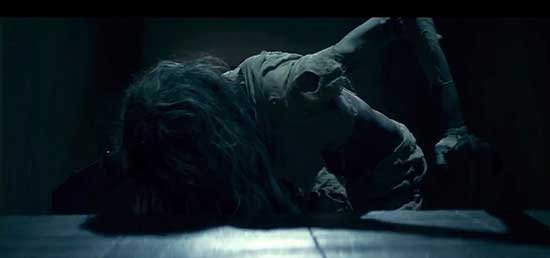 This film has a great, creepy atmosphere; the depiction of Hindu/Indian folklore brings something new to the standard old dark house story, at least for Westerners. True, the script borrows heavily from the plot of the beloved ‘80s classic Pet Sematary directed by Mary Lambert, but it isn’t an exact copy, and it even contains a couple of Easter eggs that playfully acknowledge its debt to the Lambert film. An American family of four, living in India, experiences a tragedy when the mother (played by Callies, of The Walking Dead and Colony TV fame) accidentally crashes her car and her son, Oliver, dies. She is heartbroken until her Indian housekeeper explains there’s a way for her to speak to Oliver one more time. It involves travelling to an ancient temple in the middle of a bleak, remote landscape and leaving an offering. The mother will get to speak to Oliver and say goodbye through the door of the temple, but she is warned that she must never open it while the reanimated Oliver is present. Of course she does open it and that’s when the story turns even more dark and disastrous for the family. As old Jud Crandall might say: “Sometimes, dead is better.” The house where most of the action takes place provides a wonderfully decrepit backdrop to the story and has an interesting history; it’s the house where late 19th Century author Rudyard Kipling (The Jungle Book) was born. Cinematography and pacing is excellent, as are the supporting performances. In English. 7/10. On disc and streaming.
This film has a great, creepy atmosphere; the depiction of Hindu/Indian folklore brings something new to the standard old dark house story, at least for Westerners. True, the script borrows heavily from the plot of the beloved ‘80s classic Pet Sematary directed by Mary Lambert, but it isn’t an exact copy, and it even contains a couple of Easter eggs that playfully acknowledge its debt to the Lambert film. An American family of four, living in India, experiences a tragedy when the mother (played by Callies, of The Walking Dead and Colony TV fame) accidentally crashes her car and her son, Oliver, dies. She is heartbroken until her Indian housekeeper explains there’s a way for her to speak to Oliver one more time. It involves travelling to an ancient temple in the middle of a bleak, remote landscape and leaving an offering. The mother will get to speak to Oliver and say goodbye through the door of the temple, but she is warned that she must never open it while the reanimated Oliver is present. Of course she does open it and that’s when the story turns even more dark and disastrous for the family. As old Jud Crandall might say: “Sometimes, dead is better.” The house where most of the action takes place provides a wonderfully decrepit backdrop to the story and has an interesting history; it’s the house where late 19th Century author Rudyard Kipling (The Jungle Book) was born. Cinematography and pacing is excellent, as are the supporting performances. In English. 7/10. On disc and streaming.
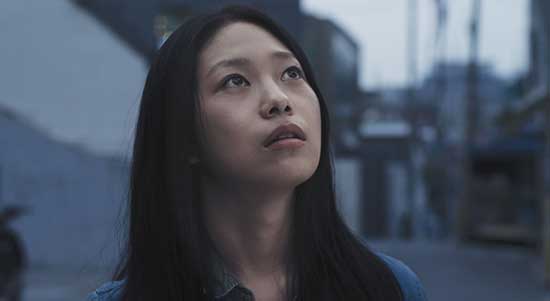 The End of April (2017)
The End of April (2017)
directed by Kwang Bok-Kim, who works mostly in Korean television; starring Ji-soo Park, Bit-na Lee, and So-Yeong Jang. This South Korean film is undeservedly obscure; I could only find one review in English and that was from an amateur blog. Yet, in my opinion, it’s one of the most memorable and disturbing entries on this list. It’s not for everyone though: fair warning! The End of April is a psychological horror that features a long build-up to a short, brutal conclusion. If you liked the much more famous Korean film, Jee-woon Kim’s A Tale of Two Sisters (2003), you will probably like this one as well. Like Two Sisters, the plot features a double fake-out: the main protagonist isn’t seeing what she thinks she’s seeing, and we, the audience, aren’t seeing what we think we’re seeing either. Fortunately, it’s easier to follow than Two Sisters and the script plays fair with the final “twist” at the end, leaving plenty of clues beforehand. The plot starts out focusing on lead actress Ji-Soo Park, who plays a woman in her mid-20s, alone in the world and very poor.
She has a terrible job at a grungy factory, where she’s harassed by a pervy, abusive boss. Her one goal in life is to pass the civil service exam so that she can get a better-paying job. She takes an apartment in a dismal complex that’s falling apart because it’s cheap and quiet enough for studying (or so she thinks.) Her nights are spent cramming obsessively for the exam, but her weird next-door neighbors distract her with their strange antics and loud noises (which include a disturbing, pig-like squealing sound). Soon, she gets roped into tutoring the neighbors’ troubled teenage daughter (Bit-na Lee), whom she comes to regard as a kind-of mentoring project. Meanwhile, an attractive, well-dressed social worker in her early 30s (So-yeong Jang) takes a professional interest in the tenants and activities of the crumbling apartment complex. Eventually, the social worker’s path intersects with the other two main characters and their previous connections are revealed. The apartment building, with its peeling and moldy walls, seedy neighborhood, and creepy inhabitants, makes for one memorable setting; no glitzy, “Gangnam Style” Korea here—this is a gloomy, unflinching look at the country’s economic losers. The acting is very good; Park won a Korean Fantastic Film Festival award for her very sympathetic performance in the lead role. This film has only got a 5.6/10 rating from viewers at the IMdB, but in my opinion, it’s an 8/10. It’s a shame this film is not better known. In Korean with English subtitles. Currently streaming at Amazon.
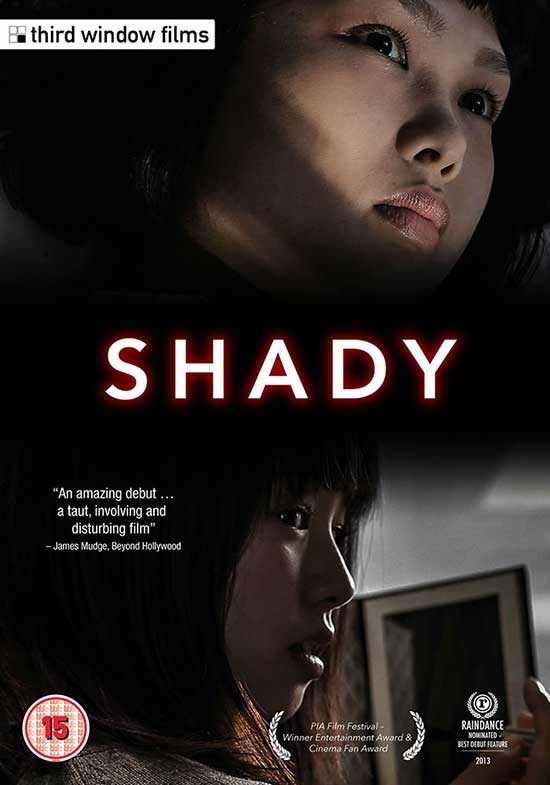 Shady (2012)
Shady (2012)
written and directed by Ryohei Watanabe; starring Hiroki Horikawa, Gota Ishida, and Juzo Kakei. This Japanese film is a throwback to the creepy Western thrillers of the late 80s/early 90s that some critics called the “From Hell” genre. You know the drill: a naïve protagonist innocently befriends a charming stranger, who later turns out to be a raving, obsessive “Psycho From Hell” who drags the protagonist through a terrifying ordeal. (Exemplified by Adrian Lyne’s Fatal Attraction (1987) and all of its numerous imitations of the era.) In this case, the naïve protagonist is Misa, a teenage school girl cruelly nicknamed “Pooh Bear” by her classmates—because she’s large and pudgy, and her surname means “bear” in Japanese. Misa becomes best friends with another girl named Izumi, who is shunned by classmates because she’s considered “too pretty” – or at least that’s the excuse Izumi gives to Misa for being a fellow outcast.
In reality, Izumi is crazy and horribly depraved, a truth that unfolds gradually as she subjects Misa to increasingly cruel and disturbing events, all the while chattering and smiling with demonic cheerfulness. In fact, the character of Izumi reminded me of the giddy torturer played by Eihi Shiina in Takashi Miike’s legendary Audition (1999) in more than a passing way. Unfortunately, the ending is a bit weak; it takes poor Misa a very long time to stand up to crazy Izumi, but eventually she finally does, with the usual outcome for the “Psycho From Hell” character. Inexplicably, the final confrontation between Pooh and Izumi occurs mostly offscreen, which is a big part of the film’s ending weakness. The acting by the two young leads is excellent; refreshingly, they seem like real teenagers, not glamorous, heavily made-up 28-year-olds pretending to be teens, as you would typically find in an American film. Reviewers at IMdB give Shady a respectable 6.9/10 rating, which I feel is about right; I’ve included it on this list because it doesn’t seem to be all that well-known outside of Japan. 7/10. In Japanese with English subtitles. Currently streaming on Amazon.
 What I Long For aka Deep Red Love (2013)
What I Long For aka Deep Red Love (2013)
directed by Kazuya Konaka from a script by Ayako Yamanoi, based on a novel by Minato Shukawa; starring Tao Tsuchiya, Fumika Shimizu, and Ryô Yoshizawa. This film is a ghost story told from the perspective of the ghost: a 15-year-old girl named Juri, who committed suicide by jumping from a top floor in her multi-story apartment building. The spirit of Juri roams through a large city (Tokyo?), revisiting familiar locations and eavesdropping on the activities of family members, strangers, and friends. She’s desperate to find someone—anyone—who can see and hear her, but most of her encounters with the living are fruitless. While not exactly scary, Juri’s aimless, ghostly travels are sad and unnerving.
Through flashbacks, we learn the reason why the teenager suicided, and it’s a pretty trivial episode to cost a young person her life: she lied to her best schoolfriend, Midori, about a boy that they were both in love with, and then couldn’t live with the guilt and shame of her betrayal. Aside from being able to move around her city at will, Juri’s ghost has one other talent: she can see otherwise invisible demons, which she calls “bugmen,” that gather around depressed or troubled people and encourage them to commit suicide. She witnesses one suicide of a man who hangs himself while the bugmen taunt him, but she’s unable to help because the man can’t see or hear her, and she can’t grab or touch him. She continues her aimless travels, until one day, she meets a tiny girl of about five playing in a park, and she realizes that the child can both see and hear her. She spends an idyllic day playing joyfully with the child, whom she nicknames “Apple.” Then, the child’s depressed and financially desperate mother shows up, and Juri notices that the bugmen are clustering around her. This scene sets up a suspenseful and tragic climax that is devastating to watch. Although it’s clearly aimed at the young adult market, What I Long For/Deep Red Love is interesting enough to hold an adult viewer’s attention. One reason why it may have a relatively low rating is that the CGI rendering of the “bugmen” is truly awful; they look like weird cartoon characters rather than scary demons. The IMdB rating is 6.1/10 (under the title Deep Red Love), but I give it a 6.5/10 for the acting and storyline. In Japanese with English subtitles. Currently streaming on Amazon under the title What I Long For.
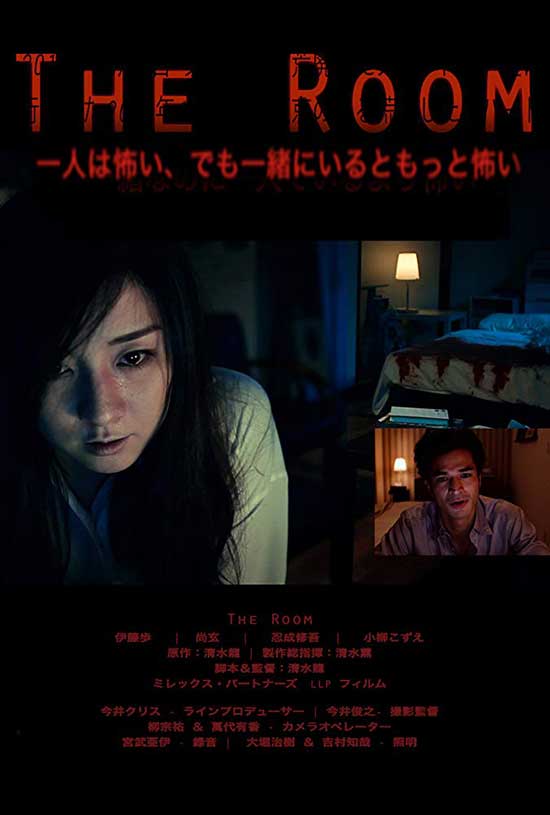 The Room (2012)
The Room (2012)
a low-budget indie Japanese film written and directed by David Shin, starring Ayumi Ito, Shogen, and Shugo Oshinari, distributed by Midnight Pulp. This psychological horror film has some major issues, but it’s considerably better than the paltry 4.1 viewer rating it currently gets at IMdB. It may remind horror fans of the first Paranormal Activity film, as well as the classic Roman Polanski creepfest starring Catherine Deneuve, Repulsion (1965). The plot starts out with a young, pretty girl named Yumi (Ito) moving into her boyfriend’s Tokyo apartment. Unfortunately, the boyfriend, Taka (played by the one-named actor known as Shogen, probably most familiar to horror fans from the 2015 Japanese miniseries Death Note) has been suddenly called away by his employer for a business trip to New York. Yumi and Taka Skype each other frequently, and their video chat sessions make up the bulk of the film. However, although The Room has been characterized as a “found footage” film, it’s not the usual genre treatment by any means. The action between Skype sessions is filmed like a normal movie, with professional lighting and editing, so there’s no shaky cams or other typical hallmarks of the genre. Consistent with a low-budget effort, this film features only three characters (Yumi, Taka and Taka’s friend, Reki) and two sets (the Tokyo apartment and Taka’s Manhattan hotel room.)
The limited sets and characters mean that Ito, like Deneuve in Repulsion, must carry most of the film, and to her credit, she does it very well. The story really gets underway when Taka and Yumi are Skyping and suddenly there’s a glitch in the transmission and Taka’s face turns demonic before returning to normal. Later that night, as she sleeps in Taka’s bed, Yumi hears weird noises and then someone banging on the apartment door, trying to get in. As the week wears on, strange noises and occasional glimpses of a haunting spirit occur in the Skype sessions, while Yumi and Taka bicker and reveal uncomfortable aspects of their relationship over their Skype connection. Yumi, who is housebound with some kind of flu, transforms from a cheerful, rosy-cheeked girl into a jittery, white-faced wreck under the pressure. If you’re familiar with the tropes of J-Horror and K-Horror, by this time you have an inkling of what’s coming: there’s an unreliable narrator somewhere in the script, and a “twist” at the end that reveals that much of what we thought we saw for most of the film was sleight of hand.  This isn’t exactly fresh, but what makes The Room worth watching is Ito’s performance as the increasingly paranoid Yumi. The film’s negatives include a few loose ends that are never really explained or resolved and a somewhat draggy middle segment. I give it a 6/10, mainly for Ito’s terrific performance. In Japanese with English subtitles. Currently streaming on Amazon and Midnight Pulp.
This isn’t exactly fresh, but what makes The Room worth watching is Ito’s performance as the increasingly paranoid Yumi. The film’s negatives include a few loose ends that are never really explained or resolved and a somewhat draggy middle segment. I give it a 6/10, mainly for Ito’s terrific performance. In Japanese with English subtitles. Currently streaming on Amazon and Midnight Pulp.
The Doll (2017)
directed by B. Tsogt-Erdene; starring N. Munkhsoyol, M. Sarantsetseg, and U. Munguntulga; distributed by Midnight Pulp. I reviewed this Mongolian film earlier this year, but I feel it’s good enough to deserve another plug. It’s so obscure it doesn’t even have an IMdB entry (as far as I know; it may be listed under another title.) The story follows a young, female office-worker named Saraa who has a dying mother and a horrible, rapey boss. She’s financially desperate and can’t pay the medical bills for her mother. One day, she buys a creepy doll from a street vendor dressed in the clothes of a rural peasant. She finds out that the doll is a vampire who offers favors in exchange for human blood. In true “Monkey’s Paw” tradition, the favors granted by the doll aren’t exactly in line with Saraa’s intentions when she makes her wishes. This film is well-directed and acted, although the ending is somewhat weak, and features at least one set piece (depicting Saraa’s revenge on her rapey boss) that would already be a classic if this were an American or British film. In Mongolian (I think) with English subtitles. 6.5/10. Currently streaming at Amazon and Midnight Pulp.
written and directed by Paul Spurrier; starring Suangporn Jaturaphut, Opal, Pisamai Pakdeevijit, and Narisara Sairatanee. This Thai film, directed by a British expat, is much better than its 5.2 IMdB rating would lead the viewer to believe. (The letter “P” stands for the Thai word for ghost.) The plot concerns an impoverished teenager named Aaw (pronounced somewhat like Oww!) who lives in rural Thailand with her wizened grandmother. When Aaw (Suangporn Jaturaphut) has a bad experience with an evil spirit lurking in a lake, the grandmother teaches her magic to protect herself. However, granny sternly warns the girl, there are three rules she must observe, or else her magic will turn unpredictable and malevolent. When the grandmother takes sick and money is needed to pay for her medicine, Aaw travels to Bangkok in search of work and ends up as a bar girl in a pub frequented by rich Westerners. She’s renamed “Dau” by the bar manager and soon finds out that prostitution is expected, as well as pole dancing and drinking with customers. Her first trick is with a Westerner who is an owner of the pub, played by Spurrier himself, and her experience is horrible. However, she learns the ropes from a more experienced girl named Pookie (the one-named actress credited as “Opal”), who offers her a place to stay and fast friendship. Aaw/Dau soon dreams of replacing the Queen Bee dancer at the bar, a beautiful but vain girl named May. When May sabotages Aaw/Dau’s audition for top dancer, the country girl uses her magic to get revenge on May, as well as on the heartless bar owner played by Spurrier. (Yes, this movie has a lot in common with Showgirls (1995), the ultra-camp Vegas classic that’s a guilty pleasure for a lot of us.) However, Aaw/Dau inadvertently breaks all three rules that her grandmother warned her not to flout. Just as granny foretold, her magic turns evil, and calls up a malevolent spirit that exits the girl’s body while she’s asleep and kills her coworkers and clients. The evil spirit seems to be a sort of astral projection of Aaw/Dau; it kills by entering a victim’s body through the mouth or eyes and eats their organs from the inside out. It’s at this point that P starts to get a little boring; the deaths committed by the evil spirit are basically all the same, and they aren’t nearly as creative as the results of the revenge magic that Aaw/Dau practices before she unleashes the evil spirit. (The revenge scene with the bar owner is grimly funny.) Still, it’s a pretty good film; the footage of rural Thailand is spectacular, and the mostly non-professional actors do a great job at building sympathy for the bar girls (especially Opal as Pookie.) In Thai with English subtitles. 7/10. Currently streaming on Netflix.
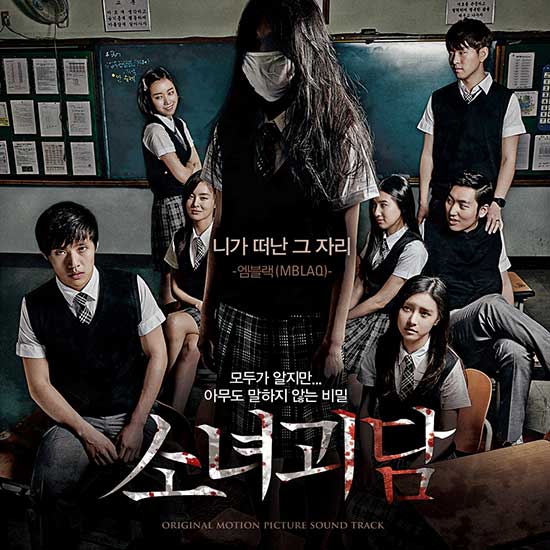 Mourning Grave, aka Girl Ghost Story (2014)
Mourning Grave, aka Girl Ghost Story (2014)
directed by In-chun Oh from a script by Jong-ho Lee; starring So-eun Kim, Jeong-tae Kim, and Hye-Rin. This Korean high school horror currently has a fairly respectable viewer rating of 6/10 at IMdB, but I think it deserves a little higher score. It tells the story of a naïve but likeable teenage boy named Sun-il (Jeong-tae Kim) who is the Haley Joel Osment of Korea. Yes, he sees dead people – lots of them. Fed up with their ghostly demands, he transfers to a new school in his ancestral town with the hopes of escaping them. He moves in with his uncle, but the uncle, who looks and acts like Jackie Chan, also sees dead people. Uncle “Jackie,” however, has figured out how to keep his ghosts mostly at bay and lectures his nephew about being too soft on his spectral visitors. At his new school, Sun-il attracts the unwelcome attention of a clique of powerful bullies who make his life miserable. He also attracts a winsome, kindly female ghost who befriends him, and they spend a lot of time together. The school is also haunted by another ghost known as The Mask – a malevolent female spirit who wears a bloody hospital mask and supposedly stalks the students. Eventually the bullies start to disappear, one by one. In the best stalker film tradition, some deaths are highly creative, including one that is a fantastic tribute to the pig’s blood scene in De Palma’s Sun-il investigates and finally pieces together the story of The Mask and how she fits in with his ghostly friend and the disappearing students. Uncle “Jackie” offers hilarious comedic relief (especially the scene where he berates a ghostly visitor for having a bad hair-cut) but also helps Sun-il survive an encounter with The Mask. The main negative about this film that it has far too many flashbacks and these are confusing; they also tend to kill the suspense of the narrative flow. Nevertheless, it’s a good plot, has good acting (especially from the uncle), and the film could easily have been better with some disciplined editing. In Korean with English subtitles. 6.5/10. Currently streaming on Amazon.
 Train to Busan (2016)
Train to Busan (2016)
directed by San-ho Yeon, from a script by Yeon and Joo-Suk Park; starring Yoo Gong, Yu-mi Jung, Dong-seok Ma and Su-an Kim. Train to Busan isn’t really that underrated; it’s only two years old but it’s already considered by many fans to be one of the greatest zombie movies of all time (which it is). However, I included it on this list because some of the good ratings it’s received aren’t nearly good enough, in my humble opinion. For instance, it’s currently rated a 7.5/10 at IMdB, with a professional Metacritic rating of only 72, but it clearly deserves a much higher rating. It’s the sort of film that would have been described as a “thrill-a-minute ride” back in the 70s, and indeed, it shares a lot of the characteristics of a classic 70s disaster film. Train to Busan follows the story of a little girl (Su-An Kim) and her newly divorced dad (Yoo Gong), as they board a train for Busan so that the girl can visit her mother. Unbeknownst to the pair, however, a zombie virus is quickly spreading throughout Korea, which is transmitted by the zombies to the uninfected by biting. An infected girl makes her way onto the train and spreads the disease throughout the train, leaving a small group of the uninfected to band together in an attempt to survive. In tried-and-true disaster flick style, the survivors are the most sympathetic archetypes possible: the sweet little girl and her dad; two elderly sisters who are devoted to each other; a pregnant woman and her husband; an impoverished homeless man, and two teenage sweethearts. From there it becomes a life-and-death struggle, and the viewer is left in nail-biting suspense anticipating which of these sympathetic survivors will make it out alive. Acting, pacing and camerawork are all great (with special kudos to the acting chops of Dong-Seok Ma, who plays the expectant father.) It’s also not a hard film for Westerners to follow – there are no multiple flashbacks, non-linear time-lines or unreliable narrators. The director knows his horror and there’s even an almost-tribute to Night of the Living Dead at the tear-jerking end. It’s one of the best horror films I’ve seen in the past year and I give it a 9/10. In Korean with English subtitles. Currently streaming on Amazon and Netflix.
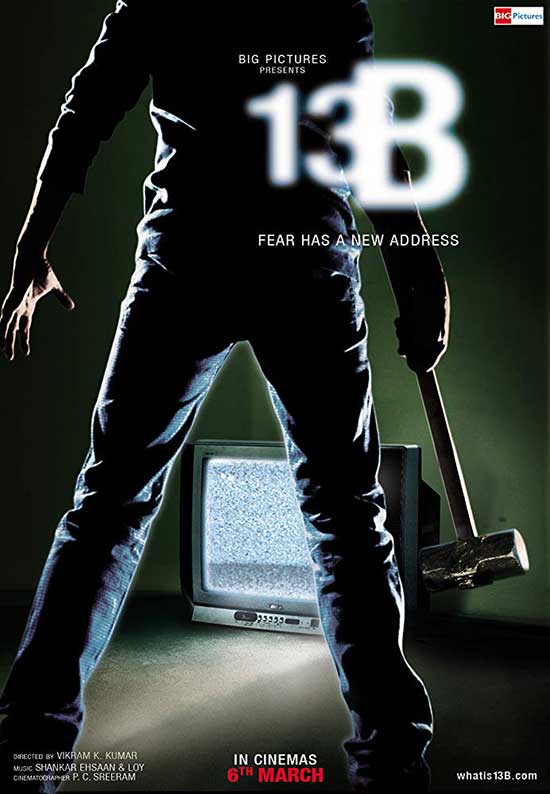 13-B: Fear Has a New Address (2009)
13-B: Fear Has a New Address (2009)
directed by Vikram K. Kumar, from a script by Kumar and Abhinav Kashyap; starring Madhavan, Neetu Chandra, and Poonam Dhillon. This Indian ghost story combines Western and Indian horror conventions to create an interesting take on the usual haunted house story. It has a very respectable 7/10 viewer rating at IMdB, but I feel that it deserves a little higher number because of its clever and original premise. It follows the story of a likeable engineer named Manohar — Manu for short — and his extended family, which includes his wife, widowed mother, kid sister, and brother and sister-in-law. As a successful professional, Manu (played Madhavan) is proud that he can afford to buy his family a large, nice flat in a brand-new building. Unfortunately, the flat carries the unlucky address of 13-B and indeed, there are signs that there’s something wrong with it after the family moves in. Milk spoils inexplicably, nails pop out of the walls and the elevator won’t take Manu beyond the second floor. His household is a traditional Indian one where the women do not go out to work, although the sister does attend college. Every day at one p.m. sharp, the women gather in front of the television to watch a new soap opera, called Everyone is Well, which they follow avidly, and then describe to the men what happens at dinnertime. Only Manu seems to notice, however, that the soap opera characters resemble his own family quite a lot. Every misfortune that happens to the television family, later also happens to Manu’s family, including his wife’s miscarriage. As the misfortunes on the show get worse, Manu becomes increasingly frantic. He sets out to investigate the soap opera, only to discover that neither the show nor the television station supposedly broadcasting it even exist. Further investigation finds that the apartment building is the former site of an old house, with the same number as Manu’s flat, where a whole family was murdered years before. When he tries to get to the bottom of the mystery, Manu gets embroiled in his own murder plot involving the secret, unpunished killer of the family. This film gets draggy in the first half, but it’s pretty suspenseful in the second; Madhavan does a great job as the frantic Manu. This being Bollywood however, there are a couple of cheesy music videos dropped into 13B seemingly at random, which stop the action cold and temporarily kill the suspense. In Hindi with English subtitles. 7.5/10.
I couldn’t find a US disc for sale, but this film has turned up on Netflix streaming in the past and may do so again. If you can’t wait, try a vpn and check on India’s Netflix, it tends to pop up there more often so you might luck out.
 Horror News | HNN Official Site | Horror Movies,Trailers, Reviews
Horror News | HNN Official Site | Horror Movies,Trailers, Reviews




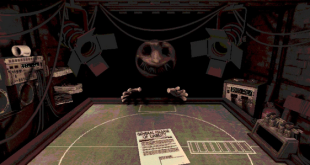
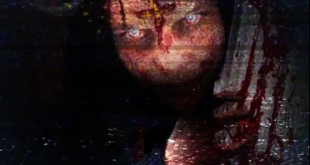

Article is not tagged; someone may want to go back and tag it. Looks great otherwise.
I always roll my eyes everytime I read an article with “…..You’ve Never Seen” on its title. To my surprise, this writer was right. The only movie I saw was TRAIN TO BUSAN. Man I need to check out some of these films.